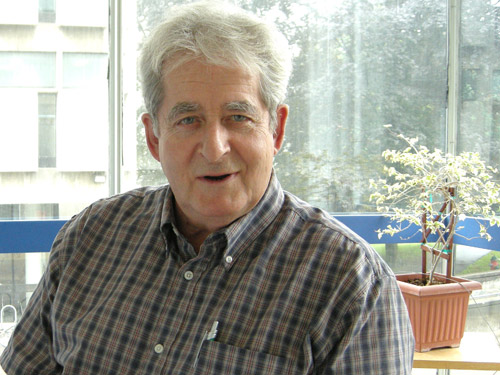
You are a parent, a spouse, a homeowner, an employee, a co-worker, a customer and many more things, all in a single day. If you have all these identities, what happens to your “self,” the real you? Is it as fragmented and fractured as all these different identities might suggest?
No, says a new theory proposed by Prof. Neil MacKinnon in a recently-published book written with David Heise of Indiana University and titled Self, Identity and Social Institutions.
And if the cover of MacKinnon’s book looks familiar, that’s because it’s a photo of a sculpture by Evan Penny at the Macdonald Stewart Art Centre. The cover of an earlier book by MacKinnon also featured a Penny sculpture from the art centre.
“I like to promote the University of Guelph,” says MacKinnon, a professor emeritus who began his teaching career at Guelph in 1972 in the Department of Sociology and Anthropology.
He describes his work ― and this book ― as being “at the intersection of psychology and sociology.” Naturally, then, he begins by discussing society. The book proposes that every society has a cultural theory of people consisting of many thousands of interconnected identities and that a person constructs his or her self by selecting identities from the society’s cultural theory of people.
The semantic and relational connections among identities create social institutions. While this concept is central to sociology, MacKinnon and Heise are the first to empirically determine the number of institutions in our society and what they are.
“We statistically analyzed the linkages between thousands of words in the Wordnet online dictionary of English words and found that there are about a dozen distinct institutions and a few emerging ones,” he says. Emerging institutions include sexuality and childhood.
These concepts create the foundation for a discussion of the self.
“The post-modernist influence in the social sciences has questioned whether people have a coherent, stable self,” explains MacKinnon. “Some have argued that a fragmented world leads to a fragmentation of the self. But we show that, indeed, people can have a core self that is coherent and stable even in our post-modern society.”
The stability of the core self, he says, is based on three components of self-sentiment: self-esteem, self-efficacy and self-expressivity. All three tend to be stable over time and as a person moves from one activity or identity to another.
“Yes, you’ll have minor fluctuations depending on the situation, but overall these are pretty stable,” says MacKinnon. These three components of self-sentiment also provide coherence to the self.
We keep our selves coherent and stable by choosing identities that maintain the self-sentiment and by enacting a compensatory identity in the wake of expressing an inauthentic one, he adds. “If you normally see yourself as a gentle person, but you have to scold or discipline a child, you might hug or comfort the child afterwards to move back to an identity you see as more authentically you.” The authors have developed a mathematical model to predict what the compensatory identity might be in each case.
If you’ve ever wondered how many identities you might have, MacKinnon and Heise have a tentative answer. The co-authors completed what they jokingly called “The Ultimate Who Am I?” test. MacKinnon explains: “The ‘Who Am I?’ test is a standard test in social psychology where subjects are asked to list their most important identities. The test allows subjects to write in a maximum of 20 identities.” Again using Wordnet to construct a list of all possible identities, they found about 9,000 identities available to people in English North America.
For their “Ultimate Who Am I?” test, MacKinnon and Heise independently went through all the possibilities, crossing those off the list that didn’t apply to them. In the end, each had about 750 current identities. Because their results were so similar, they suggest that most people might have around 700 or so identities in their identity sets.
MacKinnon sees his new book contributing to our understanding of some central issues in sociology and social psychology. “Our approach to finding and identifying institutions and identities through an analysis of language is unique,” he says, “and I think we’ve also provided an answer to the post-modern question about the existence of a core, stable self.”